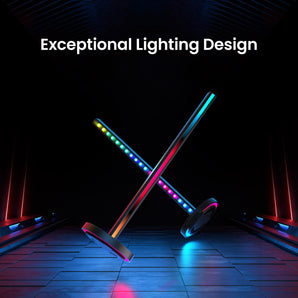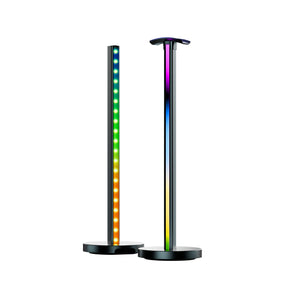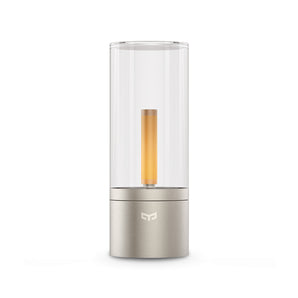Light is like this: you might not even notice it when it’s proper, but when it’s wrong, you find yourself unable to focus on literally anything. To set up the proper lighting at your home, you need to understand some fundamentals.
Light bestows us with brightness and warmth. It is the bearer of time and the soul of space. Lights, whether natural or artificial, interplays with space, performing different shades of light at different times. We thus sense the passage of time and the mood of space.
What constitutes a nice light in terms of lighting design? People, the environment, and light are all inextricably linked. A decent light is a light that respects the rule of nature and humanity and should make people feel at ease. A decent light should rhyme with the given interior design, highlighting the complexity and beauty of the area with light and shadow. A decent light knows how to cater to various scenes and emotions, allowing us to immerse in the rituals of life.

1. Luminance
The prerequisite for understanding lighting design is to understand what exactly is light. First of all, the “language” of light remains unchanged, whether we are talking about natural light, artificial light, traditional lighting design, or smart lighting design. To help you better understand light, this article will introduce several basic concepts of optics and the significance of each concept in lighting design.
How to define luminance? Well, luminance (in candela per square, i.e., cd/㎡), in the field of lighting, is a physical quantity that characterizes the intensity of luminescence reflected from the illuminating surface or illuminated surface. The unit of luminance is, according to SI base units, is candela per square, i.e., cd/㎡. In layman’s terms, luminance is the intensity of light perceived by the human eyes when seeing the light source. Therefore, it is a subjective amount, the only basic lighting parameter perceived by human’s bare eyes, which speaks about one’s most straightforward feeling of a room’s lighting. When we hear someone says, “this room is too bright”, or “there isn’t enough light, it’s too dark,” we are actually referring to luminance (Fig. 1.1.1 shows the contrast of the same setting under low luminance and high luminance).


Fig. 1.1.1 The contrast of the same setting under low luminance and high luminance.
2. Illuminance
Illuminance (in lux, i.e., lux or lx) is the amount of energy received per unit area of visible light. It is a physical quantity used to indicate the intensity of light and the degree to which an object’s surface is illuminated. The SI derived unit of illuminance is lux or lx, meaning lumen per square meter.
The two concepts, illuminance and luminance, are often confused. Unlike luminance, illuminance is an objective parameter that is determined by using a device to measure the amount of light that actually reaches a given surface. In lighting design, illuminance is referred to represent the brightness of a space or place.
To help visualize the preceding information, Fig. 1.2.1 lists the illuminance values for several scenarios that we often come across in both human society and nature.






Fig. 1.2.1 Illuminance values for common scenes.
3. Color Temperature
Color temperature (in Kelvin, i.e., K) of a light source is the absolute temperature of an ideal black-body radiator that radiates light of a color comparable to that of the light source. How is the color temperature of a particular light source specified?
In practice, if a standard blackbody is heated from absolute zero (-273°C, i.e., 0 K), when the temperature rises to a certain level, the color starts to change gradually from deep red – light red – orange red – white to blue. In this process, when a light source and a blackbody present the same color at a temperature, we refer to the absolute temperature of the blackbody as the color temperature of the light source. As shown in Fig. 1.3.1, the color temperature of a light source ranges from 2700 K to 6500 K. Whether it comes to nature or home environment, different color temperatures will trigger different sensations.

As can be seen in Fig. 1.3.1, light with a low color temperature is yellowish, and as the color temperature goes higher, the light gives off blueish rays. Since yellow is a warm color, light features a low color temperature is considered a warm light (e.g., Fig. 1.3.2 Lighting effects of a home space illuminated by a low color temperature). By the same token, blue is a cool color tone, so a high-color temperature is called a cool light (e.g., Fig. 1.3.3).


The mix of different color temperatures and different illuminations can bring people a variety of moods. Fig. 1.3.4 illustrates the people’s mood change in response to various combinations of color temperature and illuminances.

Color temperature and illuminance need to be adjusted to cater to the functions of a given space for a comfortable and healthy light environment. Table 1.3.1 gives you the recommended color temperature and illuminance for different interior spaces.


4. Color Rendering Index
Color rendering index (CRI) is the characteristic of a light source to reveal the color of an object when compared with a reference standard light source. In simple terms, it represents the extent to which the light source reproduces a given color. The better the color rendering of a light, the more realistic the colors of the illuminated objects are.
As stipulated by the International Commission on Illumination, the color rendering index ranges from 1 to 100, and the sun’s color rendering index is set to 100, which is to say, the original color of an object is the color it appears in sunlight. The color rendering index of the light sources that we commonly used is generally above 80. Some of the high-quality luminaires can reach 90 or even 95, close to the color rendering of sunlight. Fig. 1.4.1 displays the color performance of an interior space under two color rendering light sources Ra80 and Ra95. Luminaires with high color rendering index can add charm to your home.

5. Beam Angle
A beam angle – also referred to as a beam spread – is a measurement of how light is distributed. On any plane vertical to a light’s centerline, beam angle is the angle between two light rays with the light intensity equal to 50% of the maximum light intensity. The larger the beam angle, the smaller the central light intensity, and the larger the light spot. In general, a narrow beam is a beam angle of less than 20°; a medium beam is a beam angle of 20° to 40°, and a wide beam greater than 40° (Figure 1.5.1).

Beam angle lamps of different sizes give off dispersed lighting effects differently. Therefore, what needs to be considered in lighting design is to choose the right beam angle according to specific needs. Lamps with a distinctive beam angle are mostly applied to focused lighting, intended to highlight the focal point, such as decorative paintings, artwork, etc.
6. Glare
What is glare? When there are extremely bright objects or strong luminance contrast in the field of view, it will cause eye discomfort or visual weakening. This is called glare. In other words, when the brightness exceeds the degree to which the eyes can adapt, people feel irritated. Actually, glare phenomena are often encountered in our life, such as the eye-blinding car headlights at night on a dark road, or sun glare on a sunny day on the mountain.
Glare can be categorized into direct glare and reflected glare. Direct glare is the glare produced by a high luminance light source that is not adequately shaded in the field of view, while reflected glare is produced by a shiny surface illuminated in the field of view.
Glare is one of the causes that lead to visual fatigue. Inappropriate location and height of lamp installation may cause a home lighting design that is prone to cause glare to human eyes, as in, human eyes will unavoidably look directly at the light source (see Fig. 1.6.1), while scientific optical scheme and professional lighting design can effectively avoid this problem. Especially when there are children or elderly people at home who are more sensitive to glare, we should try to reduce the possibility of glare.








